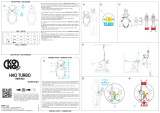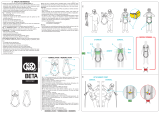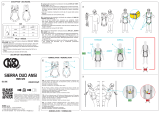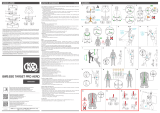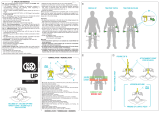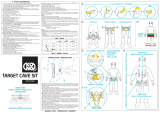Seite wird geladen ...

NOMENCLATURE SPECIFIC INFORMATION DRAWINGS
Master Text
Read and always follow the information supplied by the manufacturer
Leggere e seguire sempre le informazioni fornite dal fabbricante
Toujours lire et suivre les informations fournies par le fabricant
Die Angaben des Herstellers müssen immer gelesen und befolgt werden
Lea siempre y respete la información proporcionada por el fabricante
Download the declaration of conformity at:
Scarica la dichiarazione di conformità da:
Télécharger la déclaration de conformitè sur:
Laden Sie die Konformitätserklärung herunter von:
Descargar la declaratión de conformidad en:
www.kong.it/conformity
Please calculate the lifespan of the device according to:
Calcola la vita utile del dispositivo in accordo a:
Calculer la durée de vie de le dispositif selon:
Berechnen Sie die Lebensdauer der Vorrichtung nach:
Calcular la vida útil del dispositivo según:
www.kong.it/en/life/
Y5885000BEK KONG S.p.A. - Via XXV Aprile, 4 23804 Monte Marenzo (LC) - Italy
+39 0341 630506 | info@kong.it
WWW.KONG.IT
8W9.400 X-FIVE
A Waist belt | B Leg loops | C Chest straps | D Dorsal attachment point | E Dorsal webbing | F Sternal attachment
point | G Ventral attachment point | H LOTOR – openable ring | I Webbing loop | L Side attachment points | M Rear
attachment point | N Gear loops | O Webbing with little rings
Main metal materials: aluminium alloy and galvanised carbon steel
Main textile materials: polyamide and polyester
A Cintura | B Cosciali | C Bretelle | D Punto di attacco dorsale | E Fettuccia dorsale | F Punto di attacco sternale | G
Punto di attacco ventrale | H LOTOR – anello apribile | I Anello di fettuccia | L Punti di attacco laterali | M Punto di
attacco posteriore | N Portamateriali | O Fettuccia con anellini
Principali materiali metallici: lega di alluminio e acciaio al carbonio zincato
Principali materiali tessili: poliammide e poliestere
A Ceinture | B Passages des jambes | C Bretelles | D Point d’attache dorsal | E Sangle dorsale | F Point d’attache
sternal | G Point d’attache ventral | H LOTOR - anneau ouvrable | I Anneau de sangle | L Points d’attache latéraux | M
Point d’attache arrière | N Support porte-matériel | O Sangle avec petit anneaux
Principaux matériaux métalliques: alliage d’aluminium et acier au carbone galvanisé
Principaux matériaux textiles: polyamide et polyester
A Gürtel | B Beinschlaufen | C Schultergurte | D Rückenbefestigungspunkt | E Rückenband | F
Brustbeinbefestigungspunkt | G Bauchbefestigungspunkt | H LOTOR – aufschraubbarer Ring | I Gurtbandschlaufe | L
Seitliche Befestigungspunkte | M Hinterer Befestigungspunkt | N Gurthalter | O Gurtband mit kleinen Ringen
Hauptmetallmaterialien: Aluminiumlegierung und verzinkter Kohlenstoffstahl
Haupttextilmaterial: Polyamid und Polyester
A Cinturón | B Perneras | C Hombreras | D Punto de enganche dorsal | E Cinta dorsal | F Punto de enganche esternal
| G Punto de enganche ventral | H LOTOR – anillo abrible | I Lazo de cinta | L Puntos de enganche laterales | M Punto
de enganche posterior | N Soporte de material | O Cinta con pequeños anillos
Principales materiales metálicos: aleación de aluminio y acero al carbono galvanizado
Principales materiales textiles: poliamida y poliéster
The Category III Personal Protective Equipment 8W9.400 “X-FIVE” ( g. 1) is a full body
harness with:
- two attachment points (identi ed by “A”), one dorsal (D) and one sternal (F), certi ed according
to EN 361:02 and suitable for connection to fall arrest systems compliant with EN 363;
- a ventral attachment point (G) certi ed according to EN 813:08, suitable for connection with
restraint, work positioning and rope access systems;
- two lateral attachment points (L) and a back attachment point (M) certi ed according to EN
358:18, suitable for connection to restraint and work positioning systems.
Wearing
- Check the size suitability (SIZE table);
- loosen the adjustment straps;
- thread the legs through the belt (A) and leg loops (B);
- tighten the adjustment straps on the belt (A) and leg loops (B) – ( g. 2);
- put on the chest part of the harness, threading the arms through the shoulder straps (C);
- tighten the shoulder straps (C) and the dorsal webbing (E) to adjust both the sternal (F) and the
dorsal (D) attachment points – ( g. 3);
- insert the excess webbing into the respective elastic loops.
Important:
- before using the harness, in an absolutely safe position, carry out movements and suspension
tests on each attachment point to ensure that it is correctly adjusted and comfortable for the
intended use;
- check the buckles regularly during use.
Uses
Use in a fall arrest system (EN 361)
The dorsal (D) and the sternal (F) attachment points on the harness - marked with the letter
“A” - are suitable for connections to fall arrest systems that allow the user to reach areas or
positions in which there is a risk of falling and, in the case of a fall, limit the length and the force
of impact on the user’s body.
Examples of correct use with the BACK UP fall arrest device ( g. 6 and 7).
Use in a restraint, work positioning and rope access system (EN 813)
The ventral attachment point (G) on the harness is suitable for connecting to Working Lines
(WL) on a rope access system using that allows the user to reach and leave the work station,
under tension or suspended.
Caution:
- this connection is not suitable for fall arrest;
- the maximum load applicable to the harness for this type of use is 150 kg;
- the anchor point must comply with EN 795 and be positioned above the user;
- the connecting lanyard must always remain taut or with a maximum slack of 0.6 metres ( g. 8);
- do not connect the LOTOR (H) to the ventral attachment point (G), but to the webbing loop (I)
of the belt ( g. 9).
Examples of devices that can be connected to the ventral attachment point (G), using a
connector with a ring nut, for rope progression ( g. 10).
Use In Working Positioning and Restraint System (EN 358)
The lateral (L) and rear (M) attachment points are suitable for connecting to:
- restraint systems that prevent falls from a height by limiting the user’s movements ( g. 11);
- work positioning systems that allow the user to work supported, under tension or suspended,
and to avoid free falling ( g. 12).
Caution:
- the anchor point must comply with EN 795 and be positioned above the user;
- the connecting lanyard must always remain taut.
Compatibility
This device has been designed to be used with:
- ropes according to EN 1891;
- connectors according to EN 362;
- rope adjustment devices according to EN 12841;
- lanyards according to EN 354, EN 358;
- energy absorbers according to EN 355;
- fall arrest systems according to EN 353-1, EN 353-2, EN 360.
Caution, danger of death:
- prolonged suspension on the harness, especially if inert, can induce suspension syndrome, or
suspension trauma, which causes loss of consciousness and even death;
- the ventral (G), lateral (L) and rear (M) attachment points are not suitable for fall arrest systems.
Checks before and after use
Before and after use, make sure that the device is in an ef cient condition and that it is working
properly, in particular, check that:
- it is suitable for the intended use;
- textile parts do not have cuts, burns, chemical residues, excessive hair, wear, in particular
check the areas in contact with metal components (buckles, attachment point, etc.);
- stitching is intact, and there are no cut or loose threads;
- metal parts are free of cracks, corrosion, mechanical deformation and that any wear and tear
is only of an aesthetic nature;
- buckles work correctly (adjusting, closing and locking);
- markings, including labels, are legible.
Certi cation
This device has been certi ed by the noti ed body n° 0123 TÜV SÜD Product Service GmbH
Daimlerstraße 11 - 85748 Garching - Germany
C
F
B
A
L
G
L
N
O
G
H
I
N
D
E
M
6
3 4 5
10 1211
7 8 9
EN 795
EN 358
MAX 0,6 m
SL WL
EN 12841
type B
EN 353-2
or
EN 12841
type A
SL
EN 353-2
or
EN 12841
type A
EN 361
EN 813
EN 358

MARKINGS SIZE
INFORMAZIONI SPECIFICHE INFORMATION SPÉCIFIQUES SPEZIFISCHE INFORMATIONEN INFORMACIÓN ESPECÍFICA
Adjustment and locking of the webbing
Regolazione e bloccaggio della fettuccia
Ajustement et verrouillage de la sangle
Einstellung und Verriegelung des Gurtbandes
Ajuste y bloqueo de las correas
Il Dispositivo di Protezione Individuale di III categoria 8W9.400 “X-FIVE” (g. 1) è un’imbracatura
completa dotata di:
- un punto di attacco dorsale (D) e uno sternale (F) – contrassegnati dalla lettera “A” – certicati in
accordo alla norma EN 361:02, adatti al collegamento con sistemi di arresto caduta conformi alla
norma EN 363;
- un punto di attacco ventrale (G) certicato in accordo alla norma EN 813:08, adatto al collegamento
con sistemi di trattenuta, di posizionamento sul lavoro e di accesso mediante fune;
- due punti di attacco laterali (L) e uno posteriore (M) certicati in accordo alla norma EN 358:18,
adatti al collegamento con sistemi di trattenuta e di posizionamento sul lavoro.
Vestibilità
- Vericare l’idoneità della taglia (tabella SIZE);
- allentare le fettucce di regolazione;
- inlare le gambe nella cintura (A) e nei cosciali (B);
- tensionare le fettucce di regolazione della cintura (A) e dei cosciali (B) – (g. 2);
- indossare la parte pettorale dell’imbracatura, inlando le braccia nelle bretelle (C);
- tensionare le bretelle (C) e la fettuccia (E) per posizionare il punto di attacco sternale (F) e quello
dorsale (D) – (g. 3);
- inserire le eccedenze delle fettucce nei rispettivi passanti elastici.
Modalità di collegamento del bloccante ventrale: ssare il bloccante ventrale all’imbracatura
mediante il LOTOR (H) – (g. 4) e mantenerlo in posizione con la fettuccia dotata di anellini (O) –
(g. 5).
Importante:
- prima dell’utilizzo, in posizione di assoluta sicurezza, effettuare movimenti e prove di sospensione
su ogni punto di attacco per accertarsi che l’imbracatura sia correttamente regolata e comoda per
l’uso previsto;
- durante l’utilizzo controllare regolarmente la chiusura delle bbie.
Utilizzi
Utilizzo in un sistema di arresto caduta (EN 361)
I punti di attacco dorsale (D) e sternale (F) dell’imbracatura - contrassegnati con la lettera A - sono
adatti al collegamento con sistemi di arresto caduta che permettono all’utilizzatore di raggiungere
zone o posizioni in cui esiste il rischio di caduta e ne limitano la lunghezza e la forza d’urto sul corpo
dell’utilizzatore nel caso essa avvenga.
Esempi di corretto utilizzo con il dispositivo anticaduta BACK UP (g. 6 e 7).
Utilizzo in un sistema di accesso e posizionamento mediante funi (EN 813)
Il punto di attacco ventrale (G) dell’imbracatura è adatto per collegarsi alla linea di lavoro (WL) di un
sistema di accesso mediante fune che permette all’utilizzatore di raggiungere e lasciare il luogo di
lavoro, in tensione o in sospensione.
Attenzione:
- tale collegamento non è adatto per l’arresto di cadute;
- il massimo carico applicabile all’imbracatura per questo tipo di utilizzo è 150 kg;
- il punto di ancoraggio deve essere conforme alla norma EN 795 e posizionato al di sopra
dell’utilizzatore;
- la lanyard di collegamento deve rimanere sempre tesa o con un lasco massimo di 0,6 metri (g. 8).
- non collegare il LOTOR (H) al punto di attacco ventrale (G), ma all’anello di fettuccia (I) della cintura
(g. 9).
Esempi di dispositivi collegabili al punto di attacco ventrale (G), mediante un connettore con ghiera,
per effettuare la progressione su fune (g. 10).
Utilizzo in un sistema di posizionamento sul lavoro e trattenuta (EN 358)
I punti di attacco laterali (L) e posteriore (M) dell’imbracatura sono adatti per collegarsi a:
- sistemi di trattenuta che evitano le cadute dall’alto limitando lo spostamento dell’utilizzatore (g. 11);
- sistemi di posizionamento sul lavoro che permettono all’utilizzatore di lavorare sostenuto, in
tensione o in sospensione, e di evitare la caduta libera (g. 12).
Attenzione:
- il punto di ancoraggio deve essere conforme alla norma EN 795 e posizionato al di sopra
dell’utilizzatore;
- la lanyard di collegamento deve rimanere sempre tesa.
Compatibilità
Questo dispositivo è stato progettato per essere utilizzato con:
- corde conformi alla norma EN 1891;
- connettori conformi alla norma EN 362;
- dispositivi di regolazione della fune conformi alla norma EN 12841;
- cordini conformi alle norme EN 354, EN 358;
- dissipatori di energia conformi alla norma EN 355;
- sistemi anticaduta conformi alle norme EN 353-1, EN 353-2, EN 360.
Attenzione, pericolo di morte:
- la sospensione prolungata sull’imbracatura, soprattutto se inerte, può indurre la sindrome, o trauma,
da sospensione che provoca perdita di coscienza e anche morte;
- i punti di attacco ventrale (G), laterali (L) e posteriore (M) non sono adatti per realizzare sistemi di
arresto caduta.
Controlli pre e post uso
Prima e dopo l’uso assicurarsi che il dispositivo sia in condizioni efcienti e che funzioni
correttamente, in particolare vericare che:
- sia adatto all’uso previsto;
- le parti tessili non presentino tagli, bruciature, residui di prodotti chimici, eccessiva peluria, usura, in
particolare vericate le zone in contatto con componenti metallici (bbie, anelli, ecc.);
- le cuciture siano integre e che non vi siano li tagliati o allentati;
- le parti metalliche non presentino cricche, tracce di corrosione, deformazioni meccaniche e che
l’eventuale usura sia esclusivamente di carattere estetico;
- le bbie funzionino correttamente (chiusura, regolazione e bloccaggio);
- le marcature, comprese le etichette, siano leggibili.
Certicazione
Questo dispositivo è stato certicato dall’organismo accreditato no. 0123 - TÜV SÜD Product
Service GmbH Daimlerstraße 11 - 85748 Garching - Germania
L’équipement de protection individuelle de catégorie III 8W9.400 « X-FIVE » (g. 1) est un harnais
complet équipé de :
- un point d’attache dorsal (D) et un sternal (F) - identiés par la lettre « A » -, certiés conformément
à la norme EN 361:02 et adaptés à la connexion à des systèmes d’arrêt des chutes conformes à la
norme EN 363 ;
- un point d’attache ventral (G) certié selon la norme EN 813:08, adapté à la connexion avec des
systèmes de retenue, de positionnement au travail et d’accès par corde ;
- deux points d’attache latéraux (L) et un arrière (M) certiés selon la norme EN 358:18, adaptés à la
connexion aux systèmes de retenue et de positionnement au travail.
Port du harnais
- vérier la taille (tableau SIZE) ;
- desserrer les sangles de réglage ;
- enler les jambes dans la ceinture (A) et les passages des jambes (B) ;
- tendre les sangles de réglage de la ceinture (A) et des passages de jambes (B) – (g. 2) ;
- enler la partie thoracique du harnais, en passant les bras dans les bretelles (C) ;
- tendre les bretelles (C) et la sangle (E) pour positionner le point d’attache sternal (F) et dorsal (D) –
(g. 3) ;
- insérer l’excédent de sangles dans les boucles élastiques correspondantes.
Connexion du bloqueur ventral : connecter le bloqueur ventral au harnais à l’aide du LOTOR (H)
– (g. 4) et le maintenir en place à l’aide de la sangle spécique avec des anneaux (O) – (g. 5).
Important:
- avant l’utilisation et dans une position parfaitement sûre, effectuer des mouvements et des essais
de suspension sur chaque point d’attache pour s’assurer que le harnais est correctement réglé et
confortable pour l’utilisation prévue ;
- pendant l’utilisation, vériez régulièrement la xation des boucles et si le dispositif n’est pas
endommagé.
Utilisations
Emploi dans un système d’arrêt des chutes (EN 361)
Les points d’attache dorsal (D) et sternal (F) du harnais - marqués de la lettre A - sont indiqués pour
s’attacher à des systèmes d’arrêt des chutes qui permettent à l’utilisateur d’atteindre des zones ou
des positions pouvant comporter un risque de chute et, en cas de chute, limitent sa longueur ou la
force de choc sur le corps de l’utilisateur.
Exemples d’utilisation correcte de l’antichute BACK UP (g. 6 et 7).
Emploi dans un système de maintien, de retenue au travail et d’accès avec cordes (EN 813)
Le point d’attache ventral (G) du harnais est indiqué pour s’attacher à la ligne de travail (WL) d’un
système d’accès par corde qui permet à l’utilisateur d’atteindre et de quitter le lieu de travail, en
tension ou en suspension.
Attention:
- cette connexion n’est pas adaptée à l’antichute ;
- pour ce type d’emploi, la charge maximale applicable au harnais est de 150 kg ;
- le point d’ancrage doit être conforme à la norme EN 795 et être placé au-dessus de l’utilisateur ;
- la longe de liaison doit toujours rester tendue ou avec un mou maximum de 0,6 mètre (g. 8).
- ne pas connecter le LOTOR (H) au point d’attache ventral (G), mais à l’anneau de sangle (I) de la
ceinture (g. 9).
Exemples d’équipements pouvant être reliés au point d’attache ventral (G) pour effectuer la
progression sur corde (g. 10).
Emploi dans un système de maintien et de retenue au travail (EN 358)
Les points d’attache latéraux (L) et postérieur (M) du harnais sont indiqués pour s’attacher à:
- des systèmes de retenue qui évitent les chutes de hauteur en limitant le déplacement de l’utilisateur
(g. 11) ;
- des systèmes de maintien au travail qui permettent à l’utilisateur de travailler en étant soutenu, en
tension ou en suspension, et d’éviter la chute libre (g. 12).
Attention:
- le point d’ancrage doit être conforme à la norme EN 795 et être placé au-dessus de l’utilisateur ;
- la longe de liaison doit toujours rester tendue.
Compatibilité
Cet appareil a été conçu pour être utilisé avec:
- cordes conformes à la norme EN 1891 ;
- connecteurs conformes à la norme EN 362 ;
- dispositifs de réglage de la corde conformes à la norme EN 12841 ;
- cordelettes conformes aux normes EN 354, EN 358 ;
- absorbeurs d’énergie conformes à la norme EN 355 ;
- systèmes d’arrêt des chutes conformes aux normes EN 353-1, EN 353-2, EN 360.
Attention, danger de mort:
- une suspension prolongée sur le harnais, surtout s’il est inerte, peut provoquer un syndrome de
suspension, ou traumatisme de suspension, qui entraîne une perte de conscience et même la mort ;
- les points d’attache ventral (G), latéraux (L) et arrière (M) ne sont pas adaptés aux systèmes d’arrêt
de chute.
Contrôles avant et après l’utilisation
Avant et après l’utilisation, assurez-vous que le dispositif est dans un état efcace et qu’il fonctionne
correctement, en particulier, vériez que:
- il est adapté à l’utilisation prévue ;
- les parties textiles ne présentent pas de coupures, de brûlures, de résidus chimiques, de poils
excessifs, d’usure, en vériant notamment les zones en contact avec les composants métalliques
(boucles, point d’attache, etc.) ;
- les coutures sont intactes, et il n’y a pas de ls coupés ou détachés ;
- les parties métalliques sont exemptes de ssures, de corrosion, de déformation mécanique et que
l’usure éventuelle est purement esthétique ;
- les boucles fonctionnent correctement (réglage, fermeture, verrouillage) ;
- les marquages, y compris les étiquettes, sont lisibles.
Certication
Ce dispositif a été certié par l’organisme accrédité no. 0123 TÜV SÜD Product Service GmbH
Daimlerstraße 11 - 85748 Garching – Allemagne
Die persönliche Schutzausrüstung der Kategorie III 8W9.400 „X-FIVE“ (Abb. 1) ist einen
Auffanggurt, ausgestattet mit:
- zwei Befestigungspunkten, dorsal (D) und sternal (F), (mit „A“ gekennzeichnet), zertiziert nach der
Norm EN 361:02 und geeignet für die Verbindung mit Auffangsystemen gemäß der Norm EN 363;
- einem Bauchbefestigungspunkt (G), zertiziert nach EN 813:08, geeignet für die Verbindung mit
Rückhalte-, Arbeitspositionierungs- und Seilzugangssystemen;
- zwei seitlichen (L) und einem hinteren (M) Befestigungspunkten, zertiziert nach EN 358:18,
geeignet für die Verbindung mit Rückhalte- und Arbeitspositionierungssystemen.
Anlegen
- Überprüfen Sie die Größe (Tabelle SIZE);
- lockern Sie die Bandschlingen;
- fädeln Sie die Beine durch den Gürtel (A) und die Beinschlaufen (B);
- spannen Sie die Bänder des Gürtels (A) und der Beinschlaufen (B) – (Abb. 2);
- legen Sie das Oberteil des Auffanggurtes an und fädeln Sie die Arme durch die Schultergurte (C);
- spannen Sie die Schultergurte (C) und das Rückenband (E), um den Brustbefestigungspunkt (F) und
den Rückenbefestigungspunkt (D) zu positionieren (Abb. 3);
- führen Sie die überschüssigen Gurtbänder in die entsprechenden elastischen Schlaufen ein.
Verbindung der Seilklemme: befestigen Sie die Seilklemme mit dem LOTOR (H) an der
Gurtbandschlaufe (I) – (Abb. 4). Benutzen Sie das Band mit zwei kleinen Ringen (O), um die
Seilklemme zu halten (Abb. 5).
Wichtig:
- führen Sie jeweils vor der Verwendung in einer vollständig sicheren Position Bewegungs- und
Aufhängtests an jedem Befestigungspunkt durch, um sicherzustellen, dass der Auffanggurt richtig
eingestellt und für die beabsichtigte Verwendung bequem ist;
- überprüfen Sie während der Benutzung regelmäßig den Verschluss der Schnallen.
Verwendungen
Verwendung in einem Auffangsystem (EN 361)
Die mit A gekennzeichneten Rücken- (D) und Brustbeinbefestigungspunkte (F) eignen sich für den
Anschluss an Auffangsysteme, die dem Anwender gestatten, Zonen oder Positionen zu erreichen,
in denen das Risiko eines Sturzes besteht und die, im Falle eines Sturzes, die Höhe und die
Aufprallkraft auf den Körper des Anwenders begrenzen.
Beispiele für die korrekte Verwendung mit dem Auffanggerät BACK-UP (Abb. 6 und 7).
Verwendung in einem Rückhalte-, Arbeitspositionierungs- und Seilzugangssystem (EN 813)
Der Bauchbefestigungspunkt (G) eignet sich zur Befestigung an das Steigseil (WL) eines
Steigsystems mit einem Seil, das es dem Anwender gestattet, den Arbeitsplatz zu erreichen oder zu
verlassen, sitzend oder hängend.
Achtung:
- diese Verbindung ist nicht für die Absturzsicherung geeignet;
- die Höchstlast für den Auffanggurt beträgt bei dieser Art der Verwendung 150 kg;
- der Anschlagpunkt muss der Norm EN 795 entsprechen und sich oberhalb des Benutzers benden;
- die Verbindungsmittel (Lanyard) muss immer gespannt sein oder maximal 0,6 Metern durchhängen
(Abb. 8);
- schließen Sie den LOTOR (H) nicht an den Bauchbefestigungspunkt (G) an, sondern an die
Bandschlaufe (I) des Gürtels (Abb. 9).
Beispiele für Geräte, die mit Hilfe eines Verbindungselements mit Ringmutter an den
Bauchbefestigungspunkt (G) angeschlossen werden können, um einen Seilverlauf zu ermöglichen
(Abb. 10).
Verwendung in einem Arbeitspositionierungs- und Rückhaltesystem (EN 358)
Die seitliche (L) und der hintere (M) Befestigungspunkte eignen sich für den Anschluss an:
- Rückhaltesysteme, die Stürze aus der Höhe begrenzen und dabei die Bewegung des Anwenders
einschränken (Abb. 11);
- Arbeitspositionierungssysteme, die es dem Anwender ermöglichen, sitzend, gestützt oder hängend
zu arbeiten (Abb. 12).
Achtung:
- der Anschlagpunkt muss der Norm EN 795 entsprechen und sich oberhalb des Benutzers benden;
- die Verbindungsmittel (Lanyard) muss immer gespannt sein.
Kompatibilität
Dieses Gerät wurde für die Verwendung mit folgenden Geräten entwickelt:
- Seilen gemäß EN 1891;
- Verbindungselementen gemäß EN 362;
- Seileinstellvorrichtungen gemäß EN 12841;
- Reepschnüren gemäß EN 354, EN 358;
- Falldämpfern gemäß EN 355;
- Absturzsicherungssysteme gemäß EN 353-1, EN 353-2, EN 360.
Vorsicht, Lebensgefahr:
- längeres Hängen am Auffanggurt, insbesondere wenn dieser inaktiv ist, kann zu einem Hängetrauma
führen, das Bewusstlosigkeit und sogar den Tod verursachen kann;
- der Bauchbefestigungspunkt (G), die seitlichen (L) und das hintere (M) Befestigungspunkte sind
nicht für Auffangsysteme geeignet.
Kontrollen vor und nach dem Gebrauch
Vergewissern Sie sich vor und nach der Benutzung, dass sich das Gerät in einem efzienten
Zustand bendet und ordnungsgemäß funktioniert, und prüfen Sie insbesondere, dass:
- es für die vorgesehene Verwendung geeignet ist;
- die Textilteile keine Schnitte, Verbrennungen, chemischen Rückstände, übermäßige Behaarung
oder Abnutzung aufweisen; insbesondere sind die Bereiche zu prüfen, die mit Metallteilen in
Berührung kommen (Schnallen, Befestigungspunkte usw.);
- die Nähte intakt sind und keine abgeschnittenen oder losen Fäden vorhanden sind;
- die Metallteile frei von Rissen, Korrosion und mechanischen Verformungen sind und dass etwaige
Abnutzungserscheinungen rein ästhetischer sind;
- die Schnallen einwandfrei funktionieren (Einstellung, Schließen, Verriegelung);
- die Markierungen, einschließlich der Etiketten, lesbar sind.
Zertizierung
Zertiziert von der akkreditierten Stelle Nr. 0123 TÜV SÜD Product Service GmbH Daimlerstraße
11 - 85748 Garching - Deutschland
El equipo de protección individual de categoría III 8W9.400 “X-FIVE” (g. 1) es un arnés completo
equipado con:
- dos puntos de enganche, dorsal (D) y esternal (F) - (identicados por la letra “A”), certicados según
la norma EN 361:02 y aptos para la conexión a sistemas anticaídas según la norma EN 363;
- un punto de enganche ventral (G) certicado según la norma EN 813:08, apto para la conexión con
sistemas de retención, de posicionamiento en el trabajo y de acceso mediante cuerda;
- dos puntos de enganche laterales (L) y uno trasero (M) certicados según la norma EN 358:18,
aptos para la conexión con sistemas de retención y de posicionamiento de trabajo.
Colocación
- Compruebe la talla (tabla SIZE);
- abra todas las hebillas;
- pase las piernas por el cinturón (A) y las perneras (B);
- tense las hebillas de ajuste en el cinturón (A) y en las perneras (B) – (g. 2);
- colóquese la parte pectoral del arnés, pasando los brazos por las hombreras (C);
- tense las hombreras (C) y la cinta dorsal (E) para ajustar el punto de enganche esternal (F) y dorsal
(D) – (g. 3);
- Inserte el exceso de cinta en los respectivos lazos elásticos.
Enganche del bloqueador: conecte el bloqueador al arnés a través del LOTOR (H) – (g. 4) y
sujételo con para la trabilla equipada con anillos (O) - (g. 5).
Importante:
- antes de su uso, en una posición absolutamente segura, realice movimientos y pruebas de
suspensión en cada punto de enganche para asegurarse de que el arnés está correctamente
ajustado y es cómodo para el uso previsto;
- durante el uso, compruebe regularmente el cierre de las hebillas.
Utilizaciones
Uso en un sistema anticaídas (EN 361)
Los puntos de enganche dorsal (D) y esternal (F) del arnés son aptos para la conexión a sistemas
anticaída que permitan al usuario alcanzar zonas o posiciones en las que exista riesgo de caída y,
en caso de caída, limiten la duración y la fuerza del impacto sobre el cuerpo del usuario.
Ejemplos de utilización correcta con conexión al anticaídas BACK UP (gs. 6 y 7).
Uso en un sistema de retención, sujeción y acceso mediante cuerda (EN 813)
El punto de enganche ventral (G) del arnés es apto para la conexión a la línea de trabajo (WL) de
un sistema de acceso mediante cuerda que permite al usuario alcanzar y abandonar el lugar de
trabajo, ya sea en tensión o suspendido.
Atención:
- esta conexión no es adecuada para la detención de caídas;
- la carga máxima aplicable al arnés para este tipo de utilización es de 150 kg;
- el punto de anclaje debe cumplir la norma EN 795 y estar situado por encima del usuario;
- el lanyard de conexión debe resultar siempre tensado o con una holgura máxima de 0,6 metros (g. 8).
- no conecte el LOTOR (H) al punto de enganche ventral (G), sino al lazo de cinta (I) del cinturón (g. 9).
Ejemplos de dispositivos que pueden conectarse al punto de enganche ventral (G) mediante un
conector con tuerca anular, para la progresión por cuerda (g. 10).
Uso en un sistema de sujeción y posicionamiento en el trabajo (EN 358)
Los puntos de enganche laterales (L) y traseros (M) son aptos para la conexión a:
- sistemas de retención que evitan las caídas de altura limitando el movimiento del usuario (g. 11);
- sistemas de posicionamiento en el trabajo que permiten al usuario trabajar apoyado, en tensión o
suspendido, y evitan la caída libre (g. 12).
Atención:
- el punto de anclaje debe cumplir la norma EN 795 y estar situado por encima del usuario;
- el lanyard de conexión debe resultar siempre tensado.
Compatibilidad
Este aparato ha sido diseñado para ser utilizado con:
- cuerdas según EN 1891;
- conectores según EN 362;
- dispositivos de regulación de cuerda según EN 12841;
- cordinos según EN 354, EN 358;
- absorbedores de energía según EN 355;
- sistemas anticaídas según EN 353-1, EN 353-2, EN 360.
Atención, peligro de muerte:
- la suspensión prolongada en el arnés, especialmente si es inerte, puede inducir el síndrome de
suspensión, o traumatismo por suspensión, que provoca la pérdida de conocimiento e incluso la
muerte;
- los puntos de enganche ventral (G), laterales (L) y trasero (M) no son adecuados para los sistemas
anticaídas.
Comprobaciones antes y después del uso
Antes y después del uso, asegúrese de que el aparato está en condiciones ecientes y funciona
correctamente, en particular compruebe que:
- es adecuado para el uso previsto;
- las partes textiles no presentan cortes, quemaduras, residuos químicos, vello excesivo, desgaste;
en particular, compruebe las zonas en contacto con componentes metálicos (hebillas, punto de
enganche, etc.);
- las costuras están intactas y no hay hilos cortados o sueltos;
- las partes metálicas no presenten grietas, corrosión ni deformaciones mecánicas y que cualquier
desgaste sea sólo de carácter estético;
- las hebillas funcionan correctamente (ajuste, cierre, bloqueo);
- las marcas, incluidas las etiquetas, sean legibles.
Certicación
Este dispositivo ha sido certicado por el organismo acreditado nº 0123 TÜV SÜD Product Service
GmbH Daimlerstraße 11 - 85748 Garching - Alemania
Maximum rated load of the sit harness according to EN 813
Carico nominale massimo dell’imbracatura secondo la norma EN 813
Charge nominale maximale du harnais selon la norme EN 813
Maximale Nennlast des Gurtes nach EN 813
Carga nominal máxima del arnés según EN 813
EN 813 MAX 150kg
Attachment point for fall arrest systems
Punto di attacco per sistemi anticaduta
Point d’attache pour systèmes antichute
Anschlagpunkt für Auffangsysteme
Punto de enganche para sistemas anticaída
EN 361:2002 EN 361:2002
EN 813:2008 EN 361:2002
EN 813:2008
MAX 150kg
EN 358:2018 EN 358:2018
EN 358:2018
Sternal attachment point
Punto di attacco sternale
Point d’attache sternal
Brustbeinbefestigungspunkt
Punto de enganche esternal
Ventral attachment point
Punto di attacco ventrale
Point d’attache ventral
Bauchbefestigungspunkt
Punto de enganche ventral
Dorsal attachment point
Punto di attacco dorsale
Point d’attache dorsal
Rückenbefestigungspunkt
Punto de enganche dorsal
Side attachment points
Punti di attacco laterali
Points d’attache latéraux
Seitliche Befestigungspunkte
Puntos de enganche laterales
Rear attachment point
Punto di attacco posteriore
Point d’attache arrière
Hinterer Befestigungspunkt
Punto de enganche trasero
XS S/M L
A cm 78-92 90-115 100-130
B cm 48-58 55-65 60-70
g 2100 2150 2200
1/2
